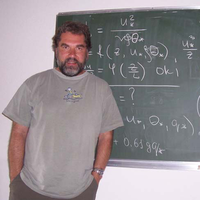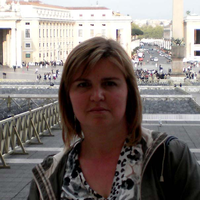 |
CROATIAN - USA
Workshop on Mesometeorology
18 - 20 June 2012 Ekopark Kraš Resort near Zagreb, Croatia
|
 |
Biographical Sketches of Lecturers
Christian Barthlott studied Meteorology at the University of Karlsruhe (diploma degree 1999) where he also
finished his Ph.D. in 2003. His dissertation was on turbulent coherent structures in the atmospheric boundary layer.
He is a currently working at the Institute for Meteorology and Climate Research (IMK) at the Karlsruhe Institute of Technology (KIT) in Germany.
 After his Ph.D., Christian stayed in Karlsruhe for working on atmospheric convection in the research
projects VERTIKATOR (Vertical exchange and topography, Germany) and CSIP (Convective storms
initiation project, UK). In 2005/2006, he was a visiting scientist at the Laboratoire de Meteorologie
Dynamique (LMD) at the Ecole Polytechnique in Paris. The work there included the study of the nonlinear
stages of the shear instability of the neutrally-stratified Ekman flow using 2D direct numerical
simulation and the impact of terrain heterogeneity on near-surface turbulent coherent structures. He then
returned to Karlsruhe to work on soil-atmosphere interactions and driving processes for deep
convection. In 2007, Christian was the coordinator of the Operations Center for the World Weather
Research Programme COPS (Convective and Orographically induced Precipitation Study).
After his Ph.D., Christian stayed in Karlsruhe for working on atmospheric convection in the research
projects VERTIKATOR (Vertical exchange and topography, Germany) and CSIP (Convective storms
initiation project, UK). In 2005/2006, he was a visiting scientist at the Laboratoire de Meteorologie
Dynamique (LMD) at the Ecole Polytechnique in Paris. The work there included the study of the nonlinear
stages of the shear instability of the neutrally-stratified Ekman flow using 2D direct numerical
simulation and the impact of terrain heterogeneity on near-surface turbulent coherent structures. He then
returned to Karlsruhe to work on soil-atmosphere interactions and driving processes for deep
convection. In 2007, Christian was the coordinator of the Operations Center for the World Weather
Research Programme COPS (Convective and Orographically induced Precipitation Study).
Christian's main current research interests are
- driving processes for deep convection over complex orography,
- processes controlling the evolution of convective systems into high-impact weather, and
- soil-atmosphere interactions.
The mail goals are the identification of these processes and the evaluation (and improvement) of their model representation.
Therefore, he combines high-resolved numerical modeling with the analysis of measured data.
Evgeni Fedorovich obtained his M.S. (1979) in Atmospheric Physics from Leningrad (St.
Petersburg) State University, Russia, and Ph.D. (1986) in Geophysics from the Main Geophysical
Observatory, St. Petersburg, Russia. He is currently a Presidential Professor at the School of
Meteorology, University of Oklahoma, USA.
 Before moving to Oklahoma, Evgeni worked until 1992 in the Main Geophysical Observatory (St.
Petersburg, Russia), was a Visiting Scientist at Ecole Centrale de Nantes, France (1992-1993), and a
Humboldt Fellow/Research Associate at the University of Karlsruhe, Germany (1993-1999). He also
taught at the University of Genoa, Italy, in 1996 as an Associate Professor.
Main areas of Evgeni’s activities are boundary layer meteorology and environmental fluid dynamics
in their relation to various aspects of atmospheric dynamics and physics. He authored and co-authored
more than 150 scientific publications in the areas of meteorology, fluid dynamics, geophysics, and
biology (of which 58 are peer-reviewed), and co-edited two books: Buoyant Convection in Geophysical
Flows published by Kluwer in 1998 and Atmospheric Turbulence and Mesoscale Meteorology
published by Cambridge University Press in 2004.
Before moving to Oklahoma, Evgeni worked until 1992 in the Main Geophysical Observatory (St.
Petersburg, Russia), was a Visiting Scientist at Ecole Centrale de Nantes, France (1992-1993), and a
Humboldt Fellow/Research Associate at the University of Karlsruhe, Germany (1993-1999). He also
taught at the University of Genoa, Italy, in 1996 as an Associate Professor.
Main areas of Evgeni’s activities are boundary layer meteorology and environmental fluid dynamics
in their relation to various aspects of atmospheric dynamics and physics. He authored and co-authored
more than 150 scientific publications in the areas of meteorology, fluid dynamics, geophysics, and
biology (of which 58 are peer-reviewed), and co-edited two books: Buoyant Convection in Geophysical
Flows published by Kluwer in 1998 and Atmospheric Turbulence and Mesoscale Meteorology
published by Cambridge University Press in 2004.
His current research efforts include:
(i) investigation of turbulence structure in the atmospheric convective boundary layer with
emphasis on the turbulence properties affecting propagation of electromagnetic and acoustic
waves;
(ii) analytical and numerical studies of buoyantly driven flows along sloping heated/cooled
surfaces (slope winds);
(iii) studies of scale structure and self-similarity of boundary layer flows along thermally perturbed
surfaces (horizontal convection flows);
(iv) numerical modeling of mesoscale atmospheric flows, and
(v) numerical studies of turbulent flow regimes in stably stratified (nocturnal) boundary layers
and nocturnal low level jets.
Scope of classes that Evgeni taught at institutions of higher education in Russia, France, Germany,
Italy, and USA extends from Atmospheric Dynamics, Atmospheric Thermodynamics, Meteorological
Measurements, and Radiation and Climate at the undergraduate level to Boundary Layer Meteorology,
Atmospheric Turbulence, Advanced Atmospheric Dynamics, and Numerical Modeling/Simulation of
Atmospheric Boundary Layer Flows at the graduate level.
Branko Grisogono obtained a B.S. and an M.S. in physics/geophysics from the University of
Zagreb. After a year of mandatory (at that time) military service, where he ended up in a punishment
unit, he moved to the Desert Research Institute, Reno, Nevada, USA, where he got his Ph.D. in 1992.
His dissertation was on the wave drag in the atmospheric boundary layer. He is currently a Professor at
the Department of Geophysics, Faculty of Science, University of Zagreb, Croatia.
 After 4 years in the USA following the Ph.D. completion (including a short post-doc), Branko moved to
the Department of Meteorology at the University of Uppsala, Sweden. It is the second oldest department
of this kind in the world after the one in Bergen, Norway. After a post-doctoral appointment in Uppsala
and being an assistant professor working on mesoscale modeling, he became an associate professor, first
at the University of Uppsala (in 1996), and then at the Department of Meteorology, University of
Stockholm (in 1997). In total, Branko stayed and worked in Sweden for 11 years. Since 2004 he has
been working at the Department of Geophysics, Faculty of Science, University of Zagreb, where he
became a full professor in 2007.
After 4 years in the USA following the Ph.D. completion (including a short post-doc), Branko moved to
the Department of Meteorology at the University of Uppsala, Sweden. It is the second oldest department
of this kind in the world after the one in Bergen, Norway. After a post-doctoral appointment in Uppsala
and being an assistant professor working on mesoscale modeling, he became an associate professor, first
at the University of Uppsala (in 1996), and then at the Department of Meteorology, University of
Stockholm (in 1997). In total, Branko stayed and worked in Sweden for 11 years. Since 2004 he has
been working at the Department of Geophysics, Faculty of Science, University of Zagreb, where he
became a full professor in 2007.
Branko’s research includes studies of buoyancy waves, atmospheric turbulence, and other aspects of
mesoscale dynamics, with particular emphasis on mountain and coastal meteorology. Throughout his
research career he studied wave drag over double bell-shaped ridge (1992), applied WKB method in
boundary layer studies (1994, 1995), investigated sea-surface effects on bora wind (1998), pure
katabatic flow (2001), and wave breaking with Coriolis effects in boundary layer dynamics (2004), and
proposed generalized mixing length-scale for stable boundary layers (2010).
Branko has (co)supervised or mentored 10 Ph.D. students and served on about 30 Ph.D. committees
in six countries. Classes that he taught over the last 16 years include Mesoscale Meteorology, Numerical
Modeling, Dynamic Meteorology, and Boundary Layer Meteorology. Presently, he is on so many
committees and has to fill out so many useless forms, that his own future research and teaching are in
jeopardy.
Nils Gustafsson received his B.S. in mathematics, numerical analysis, and statistics from Uppsala
University in 1967, and his Ph.D. in dynamical meteorology from Stockholm University in 1997. He
became associate professor of meteorology in 1998 at Stockholm University, and in 2002-2008 he was a
part-time adjunct professor of meteorology at Stockholm University.
 Nils has been employed as a researcher by Swedish Meteorological and Hydrological Institute (SMHI)
since 1967. His research interests are dynamical meteorology, numerical techniques, numerical weather
prediction (NWP), data assimilation, in particular ? variational data assimilation techniques and
ensemble data assimilation techniques, observing systems for NWP, and probabilistic forecasting.
Nils has been employed as a researcher by Swedish Meteorological and Hydrological Institute (SMHI)
since 1967. His research interests are dynamical meteorology, numerical techniques, numerical weather
prediction (NWP), data assimilation, in particular ? variational data assimilation techniques and
ensemble data assimilation techniques, observing systems for NWP, and probabilistic forecasting.
In 1989-1991 Nils was leader for the HIRLAM 2 project with participants from the Nordic countries,
Ireland and the Netherlands; in 1992-2000 he was head of the research group for meteorological analysis
and forecasting at SMHI; in 2006-2010 he was project leader for data assimilation and use of
observations in the international HIRLAM research program.
From 2012, Nils is a Subject editor for the scientific journal Tellus.
Dmitrii Mironov obtained his M.S. (1984) in Physical Oceanography from the Leningrad (St.
Petersburg) State University, Russia (USSR), and Ph.D. (1991) in Physical Oceanography and
Meteorology from the Arctic and Antarctic Research Institute, St. Petersburg. Russia. He is currently a
Senior Scientist at the Division of Research and Development, Physical Parameterization Section, of the
German Weather Service, Offenbach am Main, Germany.
 From 1984 to 1999 Dmitrii worked at various places in Europe (Institute for Lake Research of the
Russian Academy of Sciences, Leningrad/St. Petersburg, USSR/Russia; ICSC – World Laboratory,
Erice, Italy, Alfred Wegener Institute for Polar and Marine Research, Bremerhaven, Germany; Ecole
Centrale de Nantes, France; P. P. Shirshov Institute of Oceanology of the Russian Academy of
Sciences, St. Petersburg, Russia) and paid long-term visits to several research centers (International
Institute for Applied Systems Analysis, Laxenburg, Austria; University of Lund, Sweden; National
Center for Atmospheric Research, Boulder, USA). Dmitrii conducted research and published in a
number of areas including dynamics of fresh-water lakes (more specifically, he contributed to the
studies of lake thermocline, spring thermal bar, convection in ice covered lakes, and air-lake
interaction), dynamics of planetary boundary layers in geophysics (entrainment in convective boundary
layers in the atmosphere, ocean and lakes, scaling and parameterization of stably-stratified boundary
layers, bulk boundary-layer modeling), turbulence closure modeling (third-order transport in skewed
turbulence, pressure scrambling in strongly anisotropic turbulence), and large-eddy simulations of
geophysical turbulence (analysis of transport properties and turbulences structure in free and
rotationally-affected convection, homogeneous and heterogeneous stably-stratified boundary layers,
radiatively-driven convection in ice-covered lakes).
From 1984 to 1999 Dmitrii worked at various places in Europe (Institute for Lake Research of the
Russian Academy of Sciences, Leningrad/St. Petersburg, USSR/Russia; ICSC – World Laboratory,
Erice, Italy, Alfred Wegener Institute for Polar and Marine Research, Bremerhaven, Germany; Ecole
Centrale de Nantes, France; P. P. Shirshov Institute of Oceanology of the Russian Academy of
Sciences, St. Petersburg, Russia) and paid long-term visits to several research centers (International
Institute for Applied Systems Analysis, Laxenburg, Austria; University of Lund, Sweden; National
Center for Atmospheric Research, Boulder, USA). Dmitrii conducted research and published in a
number of areas including dynamics of fresh-water lakes (more specifically, he contributed to the
studies of lake thermocline, spring thermal bar, convection in ice covered lakes, and air-lake
interaction), dynamics of planetary boundary layers in geophysics (entrainment in convective boundary
layers in the atmosphere, ocean and lakes, scaling and parameterization of stably-stratified boundary
layers, bulk boundary-layer modeling), turbulence closure modeling (third-order transport in skewed
turbulence, pressure scrambling in strongly anisotropic turbulence), and large-eddy simulations of
geophysical turbulence (analysis of transport properties and turbulences structure in free and
rotationally-affected convection, homogeneous and heterogeneous stably-stratified boundary layers,
radiatively-driven convection in ice-covered lakes).
In 1999 Dmitrii joined Physical Parameterization Section of the Division of Research and
Development of the German Weather Service, Offenbach am Main, Germany, where he works on
representation of physical processes in numerical weather prediction and climate models. The focus of
his activities is on parameterizations of boundary-layer turbulence (including clouds and shallow
convection), deep atmospheric convection, lakes, and sea ice. He made a key contribution to the
development of the lake parameterization scheme FLake (http://lakemodel.net) that is implemented
into many NWP and climate models and land surface schemes.
David Raymond received his B.S. in physics from Rensselaer Polytechnic Institute in 1965. He
worked with Melvin Schwartz on weak interactions in high energy physics, receiving his Ph.D. from
Stanford University in 1970. After three years at the Hilo-based Cloud Physics Observatory of the
University of Hawaii, David moved to the physics department of New Mexico Tech, Socorro, USA, in
1973. He is currently a Professor of this Department.
 David’s work has involved atmospheric convection for most of his career. After early work on the
dynamics of mesoscale convective systems, he became interested in the Tropics as a result of
participation in 1991 in the TEXMEX project, organized by Kerry Emanuel to study tropical
cyclogenesis in the eastern Pacific Ocean.
David’s work has involved atmospheric convection for most of his career. After early work on the
dynamics of mesoscale convective systems, he became interested in the Tropics as a result of
participation in 1991 in the TEXMEX project, organized by Kerry Emanuel to study tropical
cyclogenesis in the eastern Pacific Ocean.
Shortly thereafter David participated in TOGA COARE while based in Honiara, Solomon Islands in
1992. David led the EPIC project in 2001, which studied convection in the monsoon trough south of
Oaxaca, Mexico as well as related ocean processes. Subsequent studies of tropical cyclone formation
were carried out as part of TPARC/TCS08 in the western Pacific (2008) and PREDICT in the Atlantic
and Caribbean (2010).
David's work has consistently involved a combination of observations, mostly from instrumented
aircraft, and theory, with the main goal being a better understanding of how moist convection interacts
with its environment. His major accomplishments include the development of a stochastic vertical
mixing model of shallow convection with Alan Blyth, the identification with Željka Fuchs of the
moisture mode as the likely driving mechanism of the Madden-Julian oscillation, and the analysis with
Sharon Sessions, Saška Gjorgjievska, and Carlos López Carrillo of the mechanisms of interaction
between deep convection and developing tropical cyclones.
Alan Shapiro obtained his B.S. (1983) in Atmospheric Science from Cornell University, New
York, USA, and M.A. (1985), and Ph.D. (1987) degrees in Geophysical Fluid Dynamics from the Johns
Hopkins University, Maryland, USA. He is currently a Presidential Professor and an American Airlines
Professor at the School of Meteorology, University of Oklahoma, USA.
 Following his graduate studies, Alan was a postdoctoral scientist from 1987 to 1989 at the National
Meteorological Center in Camp Springs, Maryland (now one of the National Centers for
Environmental Prediction), where he worked on the initialization of numerical hurricane prediction
models. From 1990 to 1995 he was a scientist at the Center for Analysis and Prediction of Storms
(CAPS), University of Oklahoma, where he worked on problems of radar data analysis, single-Doppler
velocity retrieval and numerical weather prediction.
Following his graduate studies, Alan was a postdoctoral scientist from 1987 to 1989 at the National
Meteorological Center in Camp Springs, Maryland (now one of the National Centers for
Environmental Prediction), where he worked on the initialization of numerical hurricane prediction
models. From 1990 to 1995 he was a scientist at the Center for Analysis and Prediction of Storms
(CAPS), University of Oklahoma, where he worked on problems of radar data analysis, single-Doppler
velocity retrieval and numerical weather prediction.
Alan joined the faculty of the School of Meteorology at the University of Oklahoma in 1996 as an
Assistant Professor, was promoted to Associate Professor in 2001 and to Professor in 2007. His
research interests are in areas of geophysical fluid dynamics (natural convective flows, waves, vortices,
katabatic flows, nocturnal low-level jets and the derivation and interpretation of exact solutions of the
Navier-Stokes equations) and Doppler radar data analysis techniques (single- and multiple-Doppler
radar wind analysis techniques, thermodynamic retrieval, advection-correction procedures, and tornado
detection algorithms).
This research has led to authorship/co-authorship of 66 peer-reviewed publications in the fields of
theoretical and applied fluid dynamics, boundary layer meteorology, mesoscale meteorology and radar
meteorology.
Alan is a regular instructor of core courses in atmospheric dynamics for undergraduate and
graduate students at the School of Meteorology, and works his research interests into elective courses
in dynamics at the graduate level.
Nataša Strelec Mahović obtained her B.S. (1992) and M.S. (1996) in physics/geophysics from
the University of Zagreb. After working for 15 years as the operational forecaster and doing scientific
work in parallel, she obtained her Ph.D. in 2011 in Geophysics-Physics of the Atmosphere and Sea from
the University of Zagreb. She is currently working as a forecaster at the Meteorological and
Hydrological Service of Croatia and teaching at the Department of Geophysics, Faculty of Science,
University of Zagreb, Croatia.
 From 1992 to 1993 Nataša was employed at the Meteorological and Hydrological Service as a research
assistant on the project "Storms and Natural Disasters in Croatia" and since 1993 she works as a
forecaster in Weather Analysis and Forecast Department. In 1993 and again in 1996 she won a
scholarship of Austrian Ministry for Science and Research, spending all together nine months at the
Austrian Central Institute for Meteorology and Geodynamics where she worked and studied in the field
of synoptic satellite meteorology and finished a research for her M.S. thesis.
From 1992 to 1993 Nataša was employed at the Meteorological and Hydrological Service as a research
assistant on the project "Storms and Natural Disasters in Croatia" and since 1993 she works as a
forecaster in Weather Analysis and Forecast Department. In 1993 and again in 1996 she won a
scholarship of Austrian Ministry for Science and Research, spending all together nine months at the
Austrian Central Institute for Meteorology and Geodynamics where she worked and studied in the field
of synoptic satellite meteorology and finished a research for her M.S. thesis.
From 2003 to 2010 Nataša was leading the Remote Sensing Office and since 2010 she is a head of
the Warnings and General Forecast Office. Since 2012 she teaches Meteorological Practicum at the
Department of Geophysics, Faculty of Science, University of Zagreb.
Nataša’s scientific activity is primarily focused on satellite meteorology: nowcast based on satellite
data, satellite-based detection, tracking and the analysis of convective systems, weather phenomena
related to convective development, and lately meteotsunamis and their generation.
Dave Whiteman obtained a B.S. in Physical Sciences from Colorado State University, an M.S.
degree in Meteorology from the University of Michigan, and a Ph.D. degree in Atmospheric Science
from Colorado State University. He is presently a Research Professor in the Atmospheric Sciences
Department at the University of Utah, where he is the head of the Mountain Meteorology Group.
 Dave has worked as an Air Force meteorologist, in private industry, as a consultant, in government
laboratories and, most recently, in academia. He worked for 24 years at the U.S. Department of Energy's
Pacific Northwest National Laboratory in Richland, Washington. His love of mountains and outdoor
activities led him into meteorology, and his professional interests are in mountain meteorology. Dave
likes to visit mountain areas, and just returned in March from a one-month visit to the mountains of
Southern Patagonia. His book, Mountain Meteorology: Fundamentals and Applications, was published
by Oxford University Press in 2000.
Dave has worked as an Air Force meteorologist, in private industry, as a consultant, in government
laboratories and, most recently, in academia. He worked for 24 years at the U.S. Department of Energy's
Pacific Northwest National Laboratory in Richland, Washington. His love of mountains and outdoor
activities led him into meteorology, and his professional interests are in mountain meteorology. Dave
likes to visit mountain areas, and just returned in March from a one-month visit to the mountains of
Southern Patagonia. His book, Mountain Meteorology: Fundamentals and Applications, was published
by Oxford University Press in 2000.
Dave has served as a visiting professor or researcher at the University of Innsbruck, the University
of Munich, the University of Bern, the University of Freiburg, the University of Vienna, the University
of Trento and the University of Canterbury (New Zealand) and at Switzerland's Paul Scherer Institute.
Dave’s career has focused primarily on meteorological observations and analyses, and he often works
with analytical and numerical modelers to gain further knowledge about atmospheric phenomena. His
publications/interests have been concentrated in:
1) valley temperature inversion buildup and breakup,
2) diurnal slope, valley and cross-valley wind systems,
3) air pollution in mountain areas,
4) persistent multi-day wintertime inversions,
5) rime and dew deposition in mountain areas,
6) mountain clouds,
7) downslope windstorms,
8) meteorological instrumentation,
9) valley exit jets, and
10) the meteorology of basins.
Dave has a strong interest in education and student knowledge acquisition, and has received both
teaching and mentoring awards. He is a Certified Consulting Meteorologist, a Fellow of the American
Meteorological Society, and a member of the American, Austrian and German meteorological societies.
He has also served as the head of the AMS's Mountain Meteorology Committee.
[ Biographical Sketches of Lecturers in  . ]
. ]

